Chronicle of space superweights. Part 3. "Marstodonts" of a new era
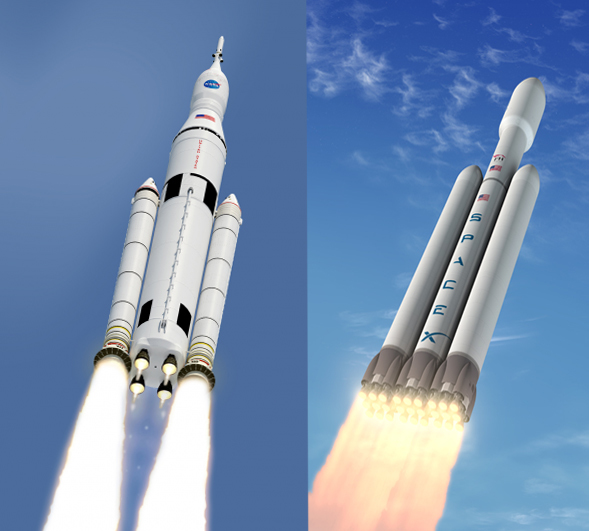
In 1984, it became apparent to NASA that the Space Shuttle system was not capable of carrying out the planned 20 annual launches announced in the original project. The search for alternative solutions led to the first work on creating more budget options for the space system.
The crash of the Shuttle Challenger in 1986 became a catalyst for the beginning of the transformation of this universal system, albeit only in the drawings, into an superheavy lunar rocket.
As we know from the previous part of the review, the Orbiter space shuttle, using its RS 25 marching engines, used an external fuel tank in the main part of the space system acceleration. Thanks to this, the Orbiter weighing about 100 tons entered the Earth's orbit. We also know from the experience of Soviet engineers who converted the OS 120 reusable system (Shuttle technical copy) into the Eneriya Buran, that such a scheme basically allows you to convert a reusable system into an ultra-heavy launch vehicle at relatively low cost.
The start of the design of the Shuttle C super-heavy launch vehicle in October 1987 was the first step in that direction.
In fact, it was practically the same system, but only 3 marching (RS 25) and 2 shunting (OMS) engines remained from Orbiter, the freed weight allowed Shuttle C launch vehicle to bring up to 77 tons of payload into low Earth orbit. Thus, NASA hoped to cover a one-year plan for launching space shuttles (which brought out no more than 25 tons at a time), as well as use a new carrier to launch large-sized orbital stations and large optical telescopes.
Schematic of the Shuttle C LV, to the right a large-scale model of the upper stage C
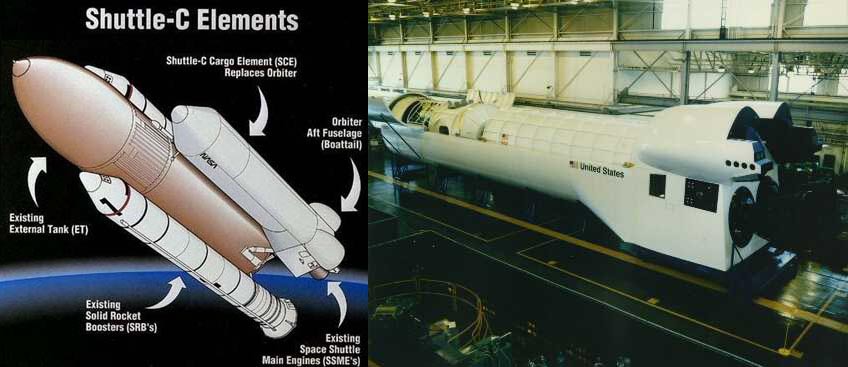
The cost of the entire amount of work was estimated at $ 2 billion, which was approximately equal to the cost of the new Orbiter. By the beginning of the 90s, despite this relatively low amount, NASA was still unable to determine the goals for the new promising launch vehicle. 2 billion were spent on the new Endeavor orbiter, and in the construction of the orbital stations it was decided to rely on the help and experience of Russia (Mir-Atlantis, ISS). The Shuttle C project was shelved in 1995. As it turned out, not for long.
In 2003, the world was shocked by another space disaster. Upon returning to Earth with the ship Columbia, his entire crew of 7 astronauts died. Ironically, it was this shuttle at the end of the 80s that was proposed to be converted into the second stage of Shuttle C LV. The leadership of the United States and NASA, it became clear that the era of the Shuttles will come to an end earlier than they expected. It was decided to rethink not only the technical, but also the ideological strategy of the American cosmonautics.
This resulted in the ambitious program "Constellation", voiced in 2004. Within the framework of this program, it was supposed to use the groundwork under the Space Shuttle program again, however, unlike Shuttle C, the power of solid propellant rocket boosters increased significantly (the thrust of both accelerators was increased to 1700 tons! Each). The TRU blocks were separated 116 seconds after the start. The external fuel tank was increased in diameter from 8 to 10 m, and 3 RS 25 marching engines were replaced with 5 simpler RS 68 from Delta 4 launch vehicle (each with a thrust of 350 tons), which were already transferred under the fuel tank itself (by analogy with the C PH unit "Energy") After 303 seconds of operation, the first stage of the LV described above was separated, after which the second stage armed with the J 2X engine (modification of the Saturn 5 second and third stage engine) put into low Earth orbit together with the Altair lunar module.
The Ares 5 launch vehicle together with the Altair lunar module The

superheavy launch vehicle was named Ares 5, the name Ares meant the main purpose of this launch vehicle - a manned expedition to Mars (the Romans called the Mars of the Greek god of war Ares). And the number 5 referred to the famous Saturn 5 lunar rocket. Ares 5 was able to put 188 tons of payload into low Earth orbit (or more than 70 tons into the moon’s orbit).
In parallel with this, the Ares 1 heavy launch vehicle was used, the first stage of which was one Ares 5 LV unit (SRB), and the second stage was also armed with the J 2X engine. Ares 1 launched the Orion manned spacecraft, which, after docking with the Altair lunar module, accelerated onto the flight path to the Moon by the second stage of Ares 5. The name of the rocket also refers to the Saturn 1 / B launch vehicle used to launch it. Apollo manned spacecraft in the 60-70s.
Ares 1 LV device

Test launch of Ares 1 LV, 2009 The closure of this project forced NASA to use the Russian Soyuz spacecraft to deliver astronauts to the ISS
In 2009, the Shuttle C project development concept (renamed to HLLV) was again proposed, some modifications of which allowed launching in near-Earth orbit already about 100 tons)
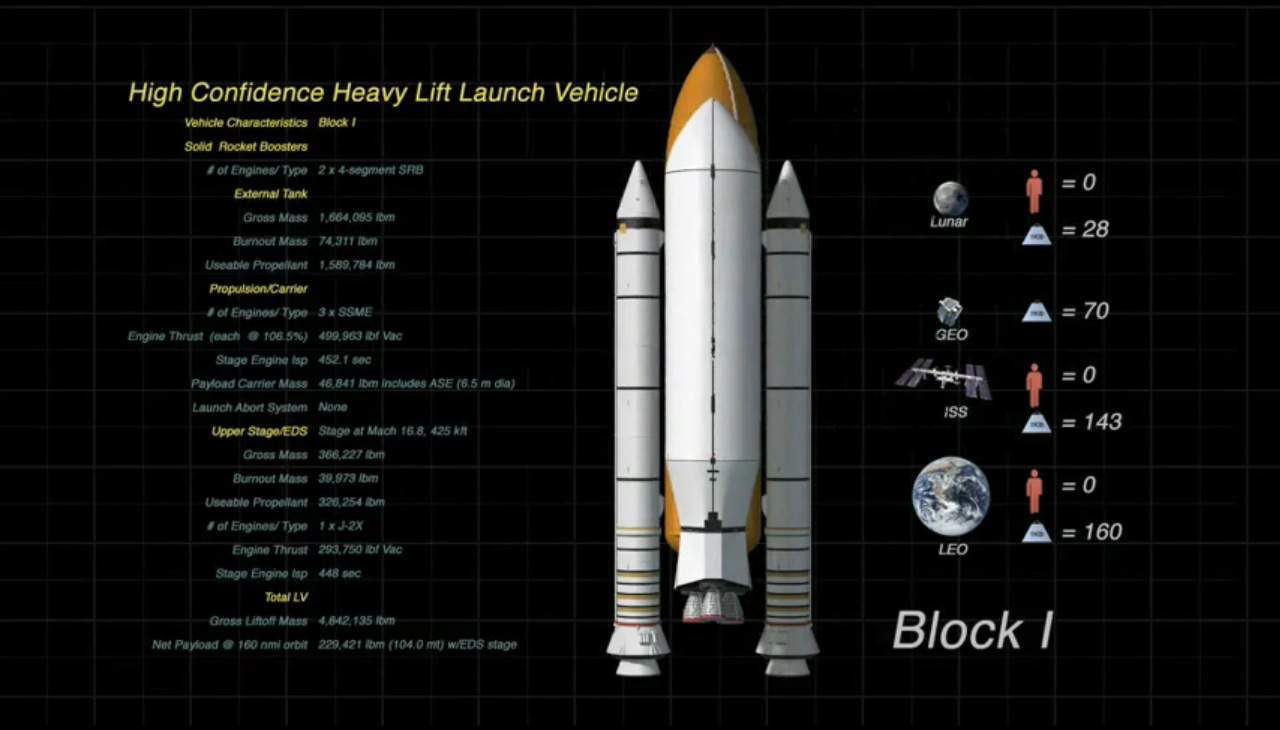
However, NASA rejected this project, and a year later, in 2010, at the peak of the global financial crisis , canceled and the program "Creation".
In 2011, on the basis of the Constellation project, it was decided to create a more “stripped down” version of both the very heavy Ares 5 rocket and the Orion manned spacecraft.
The new SLS (Space Launch System - “Space Launch System”) rocket was much less different from the basic Space Shuttle system than Ares 5. So, the 5th segment was added to the 4 original sections of the TRU. The parameters of the external fuel tank almost remained the same (with a diameter of 8.4 m). By analogy with the central block of Energia, instead of three marching engines, 4 RS 25D / E engines were installed under the original shuttle fuel tank. However, unlike Energy and Shuttle C, the output load was placed on top and not on the side. The payload was the same 70t (Block 1) as the Shuttle C. The weight of the launch vehicle increased to 3000t, the height was 121m, the total thrust at launch was 4000t (3200t of traction in the sum of two TRU units + 740t of traction 4x RS 25). A similar excess of thrust with respect to the output load (even with the 130-ton version of Block 2),
“SLS” block 1 launcher scheme
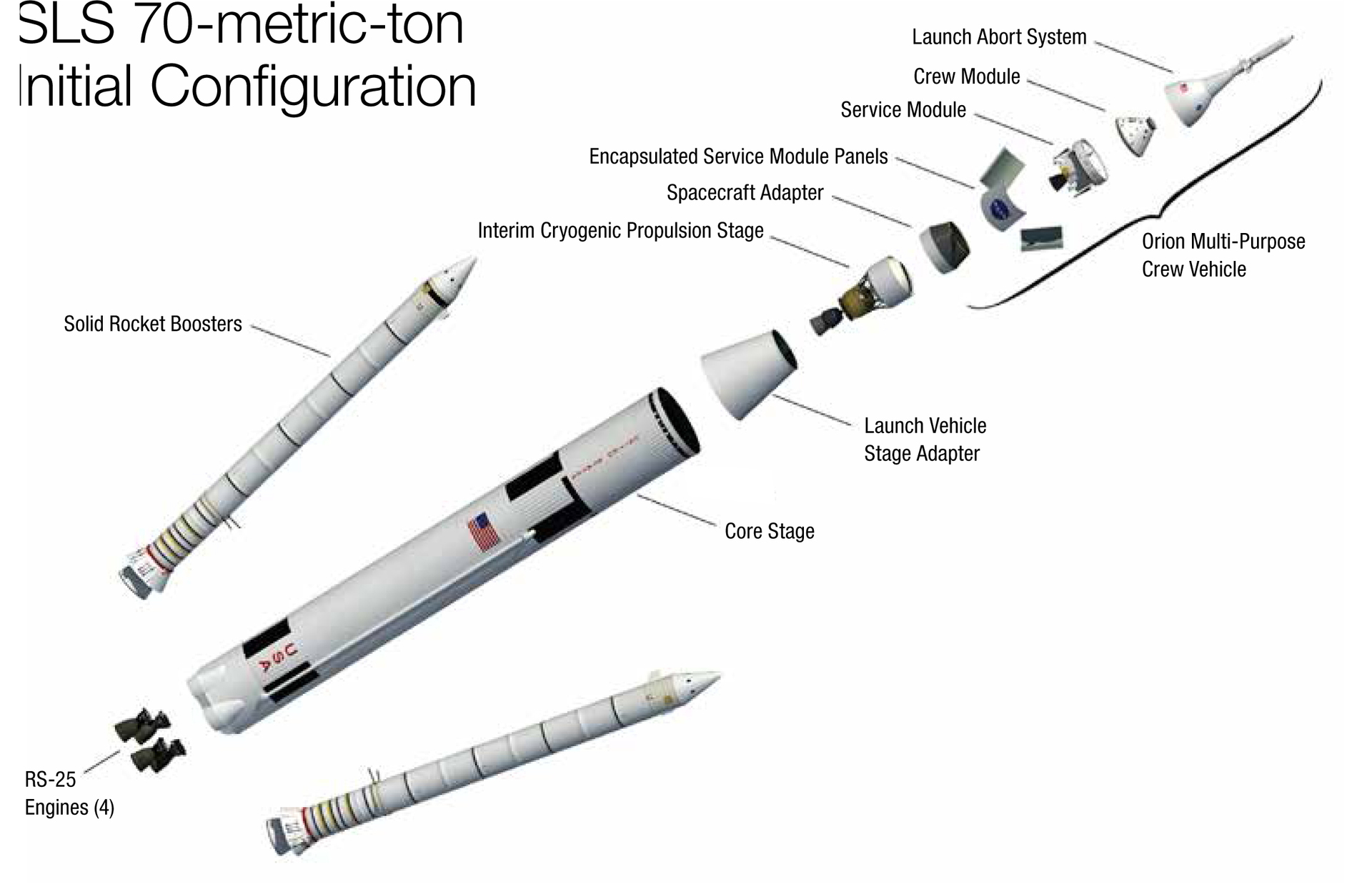
In the future, it is planned to increase the SLS thrust-to-weight ratio to 105 (Block 1A) and 130 tons (Block 2), respectively, for the first lunar and then interplanetary manned missions. The cost of the project by 2017 is estimated at $ 35 billion. The readiness of the SLS LV is estimated at 70%, the first flight is scheduled for 2017.
Different variants of the SLS

Another historical curiosity. NASA has announced a tender for the purchase of promising liquid propellant rocket engines for future versions of the SLS (in particular Block 2), due to the aforementioned low y. pulse blocks TRU. Along with Rocketdyne’s proposal for a modified version of the Saturn 5 rocket F 1 engines (F 1B with increased thrust from 690 to 800t), Aeroshet, a private space company with AJ 26 engines, entered the fray. The curious thing is that AJ 26 is an American engine modification ... NK 33, which had already been developed at the time for the Soviet lunar rocket H 1. The tender ends next year, and the new duel of the old rivals for a place in the new lunar rocket promises to be hot. However, it is possible that NASA will adopt both engines.
Concept F 1B (left) and NK 33 / AJ 26 at the Aerojet test bench (right)

On the closing year of the Constellation program, on June 4, 2010, the private company Space X, founded by Elon Musk, launched an enhanced version of the Falcon series rocket, the Falcon 9. Despite the fact that even a modified version of the Falcon 9 1.1 did not allow the payload weighing more than 14 tons (slightly less than the Zenith launch vehicle), but already in 2012 Space X announced a contract with the US Department of Defense to launch the superheavy version of the Falcon Heavy "In 2015
Elon Musk on the background of the Falcon 9 1.0 launch vehicle. Clearly visible 9 Merlin 1C engines located "square"

For this, a batch design scheme of the rocket with three Falcon 9 1.1 blocks for the first and second stages is used, armed with 9 reinforced Merlin 1D engines each. The third stage armed with a single engine Merlin 1D is used to disperse cargo into Earth orbit (5 in the diagram below). A total of 27 engines at launch develop a thrust of 1800 tons at y. impulse in 282s. The diameter of each block is 3.6 m, the height of the rocket is 68 m, the weight is 1460 tons, the mass of the payload placed in low Earth orbit is 53 tons, with a launch price of $ 100 million. In the future, reuse of the first stage blocks is planned.
Scheme of the Falcon Heavy LV, three modules of the first stage of the Falcon 9 1.1 LV have 9 Merlin 1D engines (bottom right) each. It is possible to note the characteristic “circular” arrangement of the marching engines of the LV “Falcon 9 1.1”
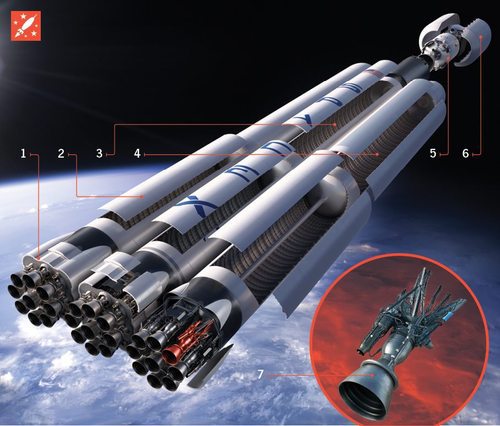
According to Space X's plans, the main goal of creating this carrier is to demonstrate low-cost means of carrying out a manned expedition to Mars ( the Red Dragon and Mars One programs ).
The modular “colleague” of the Falcon family launch vehicle, the Russian Angara launch vehicle developed by RSC Energia and NPO Energomash, is also theoretically capable of placing cargo weighing up to 50 tons into orbit. The version of the A7,2V rocket is equipped with 6 basic and one reinforced URM blocks 1 each armed with RD 191 engines. 7 engines should develop total traction at a start of 1400t. To accelerate the payload to the Earth’s orbit, the third stage unit KVTK2 with the engine rd 0124 is used. The mass of the designed launch vehicle is 1200 t, the height is 65 m. However, even for the Angara A7 version with a load capacity of 35 tons, it will be necessary to build a separate launch pad and in the next 10 years, assemblies A1 to A5 with a load capacity of 1.5 to 25 tons will be mainly used.
Various compositions of the URM 1 LV Angara blocks.
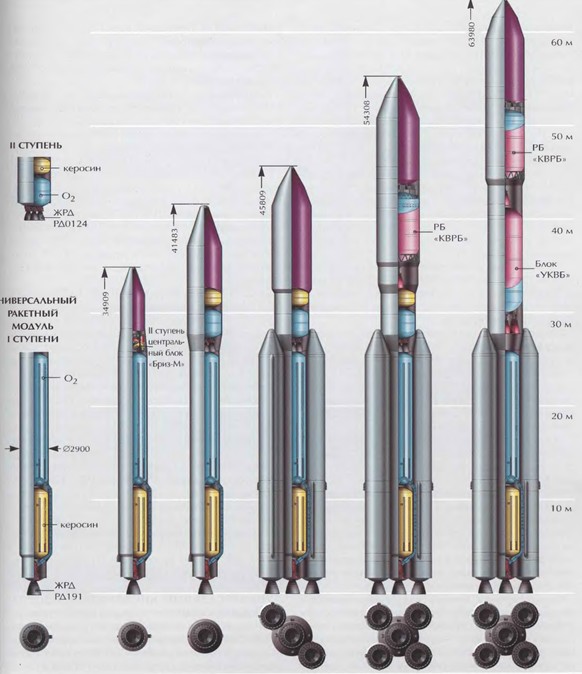

Projects of a separate superheavy LV are located in Russia ininfancy . Although our country has all the necessary means (the family of light (RD 191 / NK 33) and heavy (RD 171 / M) high-performance engines), there is no specific task for such a launch vehicle yet. However, everything can quickly change, not only against the backdrop of the successes of the American SLS and Falcon Heavy projects, but also the work in this direction of our eastern neighbors.
The hypothetical version of the superheavy Russian Yenisei 5 launcher in many respects borrows the achievements of the Energia rocket, namely 4 first stage acceleration units with RD 170 engines and second stage hydrogen engines RD 0120 (restoration of production of the latter remains a big question
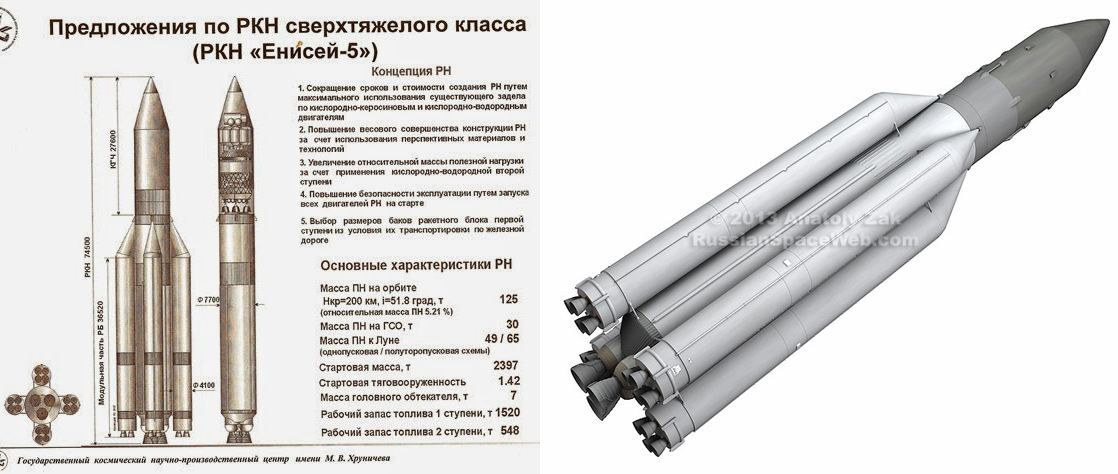
In China since 2013, at the design stage of work is the future superheavy carrier "Great March 9". Chinese engineers are actively developing the YF 660 oxygen / kerosene engine with 650t starting thrust. Four of these are planned to be used in the first stage of the launch vehicle (or 4 TRU units with a thrust of 1000 tons each).
The technological layout of the prototype YF 650 engine (left) and the YF 220 engine layout (right)

The second stage will also be armed with x4 YF 660 (version A) or x5 YF 220 (version B), and the third with two (version A) or one (version B) engines YF 220 with a thrust of 200 tons. The mass of the rocket is estimated at 4000t, the thrust at launch at 5000t, the length is 100m, and the payload is 130t. The main task of the new launch vehicle is the beginning of human colonization of our natural satellite - the Moon.
The Great Voyage 9 launch vehicle, version A (left) and B (right)

One can only wish good luck to all participants in the new race of superheavy carriers, and hopes that this time the great man’s trip into space will be the beginning of man’s full-scale development of the solar system.
Part 1. Lunar "dinosaurs".
Part 2. "Park" reusable period.
